St John's Anglican Church
Darlinghurst Road, Darlinghurst
William Hill & Son 1885 Job. no.1928 (3/34 electro-pneumatic)
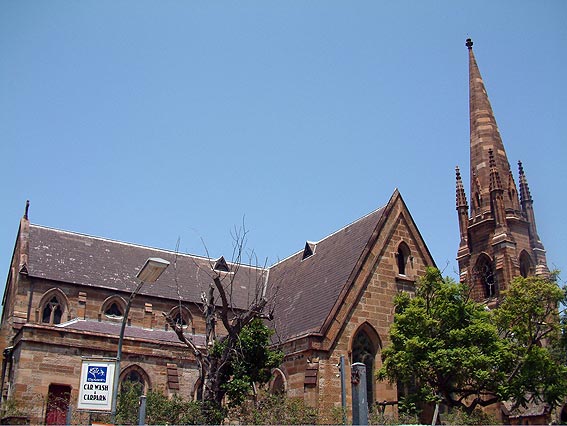
The following article was published by the organ's consultant, Dr Kelvin Hastie in the Sydney Organ Journal Autumn 1998 pp35-37.
INTRODUCTION
New South Wales is well known for its collection of largely unspoiled examples of the work of Hill & Son which represent the work of the firm in the period 1871-1910. Of the 20 Hill organs sent to the state, only one built in 1892 for Manly Presbyterian Church has been broken up and dispersed. In fortunate contrast, it is necessary to note that thirteen remain either fully or substantially intact with only six being the subject of significant alteration.
The organ at St John's Anglican Church, Darlinghurst, built in 1885 Job no. 1928) is among this latter group of six altered instruments. A history of the church, it organs and organists, is outlined in a booklet prepared in 1997 by St John's organist, Mr Ian Griggs. This is entitled "One Hundred and Thirty Years of Organ Music" 1. The original specification and plans for a gas-operated blowing plant are to be found in Graeme Rushworth's "Historic Organs of New South Wales" (Hale & Iremonger, Sydney 1988), pp 274-5.
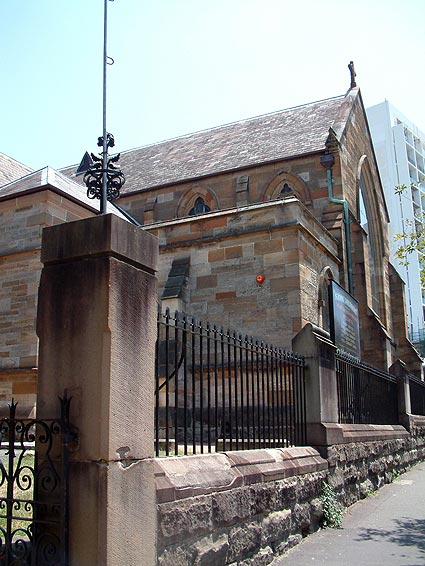
Originally constructed with mechanical action for all divisions excepting the Great, which was controlled by pneumatic lever, a drawback of the original design was the placement of the console in a vestry immediately adjacent to the chancel. While the player would doubtless have had a view of part of the choir, there would have been no visual or effective aural communication with the congregation. It is not surprising, therefore, that the church engaged W. L. Roberts of Adelaide to rebuild the organ in 1929-30. Electro-pneumatic action was installed, a new detached stop-key console was located adjacent to the chancel steps, and tonal modifications were made to the Pedal division. The scheme also included additional couplers and preparation (at the console) for three additional Choir stops.
Although a well-built electro-pneumatic action can sometimes yield a life expectancy of some 50 years with generous maintenance and cleaning, experience in this country has been that such actions commonly need replacement after 30-40 years. As few older Sydney organists can recall a time when the Darlinghurst organ functioned reliably, it is fair to say that the Roberts action reached the end of its viable life after only 30 or so years. As a result, several firms were called in to carry out repairs on the organ in the post-war period, but of greatest impact was the work undertaken in the 1971-76 period by Anthony Welby (together with volunteers) and Arthur Jones. The latter builder completed some soundboard repairs and revoiced several ranks immediately prior to his departure for England in 1972 2. A Kimber-Allen electro-mechanical relay system was also installed during this period. The repairs of the 1970s were not substantial enough to enable the organ to function reliably and this was patently obvious to Organ Society members during the ramble visit of June, 1993.
Mr Herbert Woodhouse, organist at Darlinghurst for about eight years prior to is resignation in early 1994, was responsible for initiating moves to renovate be Hill organ. Because funding from church sources was limited, an application for financial assistance was made to the Heritage Council in March 1991 3. At that time, the author was invited by the church to fill the position as consultant. The altered status of the instrument initially mitigated against the award of a heritage grant, principally because other important and intact organs were a greater priority. Not to be deterred, further applications were submitted by the church and in 1993, it was awarded $10,000 to assist the restoration of the Swell soundboard. Further funding came from the sale of the 1880 Hele & Co organ in St Peter's, East Sydney: these funds were put aside for a new console. (St Peter's was closed in 1993 and its congregation transferred to St John's, Darlinghurst: the Hele organ was restored by Pitchford & Garside and placed in St Finbar's Catholic Church, Glenbrook, in 1995). At that stage the church was not prepared to commit funds to a larger project although the author had strongly recommended the full repair and renovation of the organ in January 1994 4.

The Swell soundboard was restored by Peter D. G. Jewkes Pty Ltd in early 1995.A standard process of dismantling, cleaning, planing, repairing and pallet releathering took place. Traditional materials such as hot animal glue and graphite (for slider lubrication) were used. The table was repaired and planed true, sliders and bearers repaired and refitted, toeboards, rackboards and rackboard pillars were repolished and reassembled. A new bottom board was fitted because the original was seriously damaged and had too many cracks and splits to warrant repair.
While it was originally envisaged that the Swell soundboard would be the only part of the organ to be restored, during dismantling for the Swell repairs, extensive termite damage to the bellows and building frames was revealed. The organ could not therefore be realistically reassembled and the parish council voted in mid-1995 to proceed with a full-scale renovation. At that time it we suggest ed that a west gallery be built in order to relocate the organ. Owing to the enormous cost (estimated at over $100,000) and aesthetic/spatial problems identified by the church's architectural adviser (Alan Croker of Design 5 Architects in Surry Hills), the gallery plan was shelved 5.
In August 1995 the parish council advised the author to proceed with formulating a tender document, which contained a statement of significance for the organ, and a schedule of work to be carried out. The parish council also drew up clear guidelines as to administrative procedures and roles. Mrs Sonia Fenton, a councillor for the Municipality of South Sydney, was appointed project manager. Early in 1996 Mrs Fenton submitted a second application to the Heritage Council for further funding and later that year, $20,000 was allocated to the project. An additional $19,000 was released from the St John's Darlinghurst Restoration Appeal fund, controlled by the National Trust of Australia (NSW). Four organ builders were invited to submit a tender and these were received in February, 1996. On 10 April 1996 the parish council awarded the contract to Peter D. G. Jewkes Pty Ltd, on the strength of his previous association with the St John's organ, a competitive tender price, and most importantly, positive reports from other churches as to the firm's suitability for this type of work. In particular, the highly successful outcome of the Hill organ project at St John's Anglican Church at Toorak in Melbourne was influential.
A contract specification of 24 pages (based on the tender specification) was formulated by the author in May 1996 and this contains a statement of significance, a conservation policy, a schedule of work and contractual terms. Both contractor and consultant have been grateful for the continued support and encouragement of the Rector, Revd Dr Bill Lawton, the St John's Parish Council and the parish administration.
THE RENOVATION PROJECT DESCRIBED
It is important to note that the project has been described as a 'renovation'. Unfortunately, restoration of the organ to its 1885 state was not considered viable in terms of cost and the unfavourable position of the original console. Moreover, installation of a mechanical/pneumatic lever action playable from a console position in the chancel was not viable either, owing to a lack of space. Wltile the project could be termed a 'rebuild', this label is not entirely accurate owing to the dominance of conservation work. The term 'renovation' is therefore the most appropriate choice. Original surviving 1885 components were:
(a) The large 12ft x 6ft main bellows, albeit cut down to single-rise earlier this century.
(b) Much of the original wind trunking.
(c) All manual and pedal soundboards.
(d) Virtually all pipework. The Swell Oboe 8ft had been largely destroyed by volunteers during an attempted tonal modification in the early 1970s. The Choir Vox Humana 8ft had been replaced by a Palmer rank of very fine quality, probably in the 1930s.
(e) The Swell box.
(f) The Casework, excepting the panels and pipe rack originally over the console in the vestry. (The diapered pipes in this display were part of the Choir Dulciana and had survived on an off-note chest). The aim of the project was to repair all surviving Hill components according to the principles outlined in the Australian Pipe Organ Preservation Standards (Organ Historical Trust of Australia, 1992). New material was to be identifiable as such, but at all times remaining in harmony with the original. Modern accretions (such as wiring, additional panelling, new wind trunking, electric stop motors, etc.) were to be fitted with discretion.
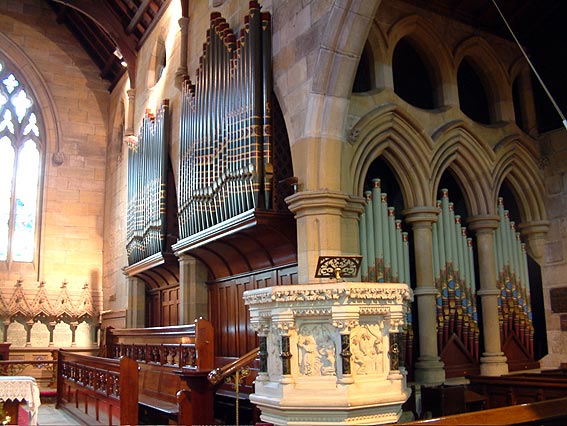
DETAIL OF WORK
Site preparation.
The church's carpenter, Mr Rod Langpeach, was responsible for preparing the site. Because of termite damage, the chamber floor was replaced and strengthened. A pit was dug to accommodate the blower (BOB X 10B); it is lined and fitted with a pump to remove seepage.
A new platform was built to hold the Choir division which since the Roberts rebuild, had faced into the chancel through the second archway. Timber walls were built to seal off the organ chamber from the vestry. These doubtless contribute to the improved tonal projection of the organ into the building, as does the new protective box placed around the Choir division. Tunnels were bored under the chancel to accommodate the console cabling. (The new console is located in the north transept).
Wind system.
New trunks were made to fit between the new blower position and the bellows, and the Roberts bellows valve was rebuilt. The large bellows was restored to double-rise operation, using a new floating frame made in kauri. Because of termite damage, the well frame was completely replaced, also in kauri. Finest quality white sheepskin was used to releather the bellows. New metal counterbalances were forged in iron. Timber surfaces were repainted using the traditional Hill grey/green colour.
The Roberts Choir bellows was so severely damaged by termites that it was discarded. The 1885 Hill bellows for the
pneumatic action (converted by Roberts to a pneumatic stop-motor reservoir) was restored for use as the Choir bellows: restoration procedure followed that used for the main bellows.
The Great concussion bellows was releathered and new tremulants and concussions (designed for shut-off when the tremulant is engaged) for the Swell and Choir were installed. All existing wind trunks were cleaned, repaired and resealed with fresh leather joints. New trunks (for the Choir and Pedal slider chests) were made in timber.
Soundboards and windchests.
Restoration of the Swell soundboard is described above. As the Great had been restored by Anthony Welby and Arthur ones, only minor work was carried out. This consisted primarily of releathering the C# side pulldown motors.
The Pedal Open Diapason windchest (separate from the main pedal slider soundboard) required extensive restoration. The chest was dismanded, cleaned and cracks routed and slled with new timber. Wind channels were sealed with animal glue and the pallets were stripped and recovered in felt and leather. The Roberts pulldown motors were recovered in splitskin.
The Choir and Pedal slider soundboards were also fully restored, using techniques similar to those described above. Tables were stripped, re-screwed to the bars where lifting was in evidence and recovered in graphite. The sliders and bearers were trued up, with sliders regraphited. The upperboards, rackboards and rackboard pillars were repaired and repolished. The bars were covered in glued canvas and the pallets were recovered.
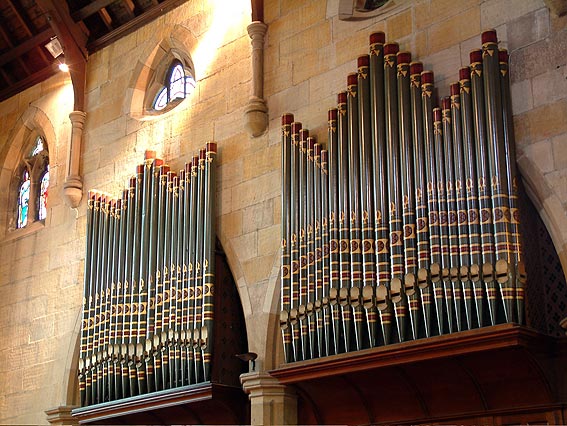
Buildlng frames and Swell box.
The surviving Hill building frames were repaired and repainted. with termite-affected sections renewed. A new frame was made for the Choir in sugar pine. (When Roberts rebuilt the organ in 1930 the Choir was merely bracketed to surrounding walls and panels).
Action.
Electro-pneumatic action was retained throughout. It consists of lever magnets acting on valves which exhaust the pallet pulldown motors fitted by Roberts. A completely new underaction was made for the Swell and the Choir action was substantially rebuilt. New silent solenoid stop motors were fitted. All action parts were placed in protective timber covers, not only to keep dirt out and reduce noise, but also to reduce the visual impact of modern componentry. The entire action was rewired and connected to a solid-state control system provided by Solid State Logic of Brandon, Suffolk.
Pipework.
All metal fluework was cleaned (but not washed) and repaired. Seriously damaged pipes were sent to Australian Pipe Organs of Melbourne for specialist attention. This firm also. carried out extensive repairs to the reeds, as many of these were in very poor condition. A full set of new tuning slides was supplied to replace the worn set, much of which dated from 1930.
Wooden pipes were stripped of unoriginal paint (some stoppers had been covered in gold in the early 1970s!) and repolished, with the greatest care taken to reserve original inscriptions. Stoppers were releathered and tuning devices on open pipes repaired.
The Roberts Pedal Bourdon extensions (downwards to the bottom E pipe of the 32ft register and upwards to 8ft were discarded and the stop returned to its original position on the Pedal slider chest. Likewise, the Roberts Pedal Trombone 16ft extension (12 pipes) was discarded. A new Trombone 16ft (of 30 notes in spotted metal) was ordered from Orgues Létoumeau, of Canada: this firm was also given the order for the new Swell Oboe 8ft, being supplied with some remnant 1885 pipes to act as a guide for constructional and scaling information.
All pipes were carefully regulated where necessary and the utmost attention was given to preserving the original speech and voicing characteristics. It was found that interference in the 1970s had been largely restricted to the Swell chorus (Open Diapason softened; upper work loudened) and possibly, the Great Hohl Flute and Choir Gedact. Pipes in these ranks were judiciously re-regulated to bring them back into the balance characteristic of Hill organs of this period.
Casework.
Only basic repairs were carried out to the simple panelling of the chancel casework. The chancel front pipes (repainted in the 1970s and in reasonably good order, but probably with a colour scheme not entirely original) were cleaned, repaired where necessary and re-installed. The transept dummy pipe front presented a problem, in so far as several pipes were badly damaged and others were missing. (Missing pipes were replaced by new ones supplied by Australian Pipe Organs). The transept facade had also been painted rather inartistically in the 1970s, but was in fair condition. Ian Griggs carried out extensive tests to determine the original colour scheme and has redecorated these pipes using the techniques outlined on pp 55-57 of his booklet "One Hundred and Thirty Years of Organ Music". The restored facade creates an impressive appearance in the transept.
Console.
Because it was not possible to reconstruct an attached Hill console in period style, it was decided to build a new detached console. Suitable reference to the work of Hill & Son in the post-1900 period (when they were producing detached consoles) may be detected in the cabinet profiles, the turned key cheeks, the 'ogee' key profiles and the solid ivor-resin drawstops, with block lettering in the Hill style. Such features provide a suitable visual and tactile relationship with the organ itself, almost as if Hill & Son had rebuilt the organ in the early 20th century. Measurements taken from the preserved 1910 Hill organ at Pitt Street Uniting Church in Sydney were most useful, as was John Stiller's documentation of that organ.
The console is not a slavish copy: it is unmistakably a modern accretion and is identifiable as such. A comprehensive set of pistons, a sequencer, a balanced swell pedal and a concave/radiating pedal board have thus been provided. The console components were manufactured by P & S Organ Supply Co., of Brandon, Suffolk. This firm also made similar fittings for the organ at St John's Church, Toorak.

OUTCOME
The overall results of the project have exceeded expectations: the projection of sound into the building is stronger and clearer than was envisaged. The action is prompt and free from extraneous noise and the regulation is balanced and graded according to Hill convention throughout the compass. Noteworthy aspects of the tonal scheme are the characteristically bold principal choruses (unmistakably Hill), the superbly voiced flutes (the Swell Stopped Diapason 8ft and Choir Flute d'Amour 4ft are especially fine), the colourful reeds and the clear and prompt Pedal stops. Of particular note are the Violoncello 8ft and Fifteenth 4ft (almost a Choral Bass), which must surely count among the best examples of their type in the country.
At the time of writing the Oboe and Trombone rank were still on their way from Canada, being shipped with the renovated Hill organ for St Andrew's Cathedral, Sydney. The Trombone will be placed on its own electro-pneumatic chest behind the Swell division.
The project has been a massive undertaking for Peter D. G. Jewkes Pty Ltd. The firm is to be thoroughly commended for its diligence and professional approach to the task.
The nomenclature is taken from the Hill order book entry supplied by Graeme Rushworth. Where this employed abbreviations, standard Hill usage of the period was adopted. Apart from the Trombone 16ft, tremulants and couplers, the specification is the same as that listed in 1885.
A similar article to this appeared in OHTA NEWS Vol. 22, No. 1, January 1998.
References:
1. This can be purchased by sending a cheque or money order for $9.95 to St John's Church, 120 Darllnglmrst Rd Darlinghurst NSW 2010. Postage is included.
2. Clive Arkley, pers. comm. to author, 22 January 1980.
3. Organ Historical Trust of Australia, NSW Committee of Council Minutes, 15 May 1991.
4. Kelvin Hastie, Organ Report: St John's Anglican Church, Darlinghurst, 31 January 1994. P 4.
5. Alan Croker, Architect's Report on restoration and relocation of organ at St John's Church Darlinghurst, 12 July 1995.
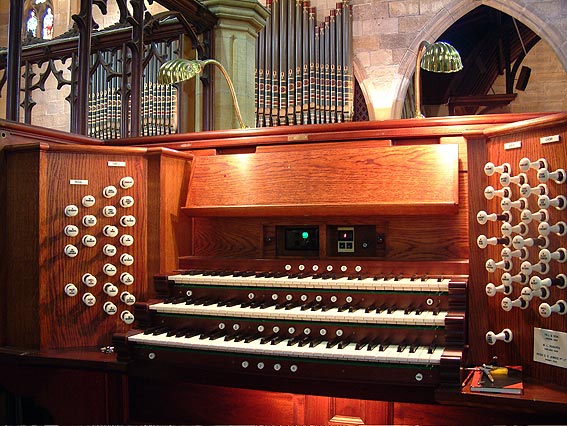
© PdL 2006
William Hill & Son 1885 Job. no.1923 (3/34 electro-pneumatic)
The current 1998 specification is:
| Great Bourdon Open Diapason I Open Diapason II Hohl Flute Principal Harmonic Flute Twelfth Frifteenth Mixture 17.19.22 Posaune Swell Bourdon Open Diapason Stopped Diapason Gamba Voix Celeste TC Principal Fifteenth Mixture 17.19.22 Horn Oboe + Clarion Tremulant Choir Duciana Gemshorn Gedact Flute d'Amour Flautina Clarionet TC Vox Humana* Tremulant Pedal Open Diapason Bourdon Principal Violoncello Fifteenth Trombone + Couplers Great to Pedal Swell to Pedal Choir to Pedal Swell to Great Choir to Great Swell to Choir Swell Octave Swell Unison Off Swell Sub-Octave Choir Octave Choir Unison-Off Choir Sub-Octave Great and Pedal combinations coupled |
16 8 8 8 4 4 2-2/3 2 III 8 16 8 8 8 8 4 2 III 8 8 4 8 8 8 4 2 8 8 16 16 8 8 4 16 |
Accessories
6 pistons for Great
6 pistons for Swell
4 pistons for Choir
6 pistons for Pedal
6 general pistons (above Swell manual)
Simple sequencer
Piston setter
General Cancel
Electro-pneumatic action
Total number of pipes: 1,948
Compass 56/30
+ Pipework by Orgues Létourneau Ltée, Quebec, Canada (1997)
* Pipework by Alfred Palmer & Sons, London, (probably 1930)